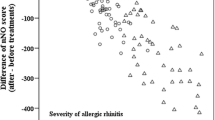Abstract
Symptoms in non-allergic non-infectious perennial rhinitis (NANIPER) are characteristically trigged by non-specific irritants. Hyper-responsiveness to cold dry air has been demonstrated in NANIPER. Bradykinin is a peptide involved in allergic inflammation. Neurally mediated hyper-responsiveness to bradykinin has been demonstrated in allergic rhinitis. The purpose of the present study was to investigate whether hyper-responsiveness to bradykinin is present in NANIPER. Normal subjects (n = 13) and subjects with NANIPER (n = 10) were subjected to a nasal bradykinin challenge protocol. Secretory responses were measured using filter paper disks, and congestive responses measured using acoustic rhinometry. Compared to normal subjects, with NANIPER had a greater secretory response to control challenge with Hartman’s solution. On the other hand, the normal ipsilateral secretory and congestive response to bradykinin was absent in NANIPER. Subjects with NANIPER did not demonstrate any evidence of reflex responses to bradykinin, and no evidence of nasal hyper-responsiveness to bradykinin. Hyper-responsiveness to bradykinin is absent in NANIPER. These results suggest that autonomic hyporesponsiveness rather than neural hyper-responsiveness may be an important factor in the etiology of NANIPER.


Similar content being viewed by others
References
Austin CE, Foreman JC (1994) A study of the action of bradykinin and bradykinin analogues in the human nasal airway. J Physiol 478:351–356
Braat JPM, Mulder PG, Fokkens WJ, Gerth van Wijk R, Rijntjes E (1998) Intranasal cold air is superior to histamine challenge in determining the presence and degree of nasal hyperreactivity in non-allergic non-infectious perennial rhinitis. Am J Respir Crit Care Med 157:1748–1755
Gerth van Wijk R, Dieges PH (1991) Nasal hyperresponsiveness to histamine, methacholine, and phentolamine in patients with perennial non-allergic rhinitis and in patients with infectious rhinitis. Clin Otolaryngol 16:133–137
Gluckman JL (1995) Non-allergic rhinitis. In: Donald PJ, Gluckman JL, Rice DH (eds) The sinuses. Raven Press, New York, pp 145–155
Haavisto L, Sipila J, Suonpaa J (1998) Nonspecific nasal mucosal reactivity, expressed as changes in nasal airway resistance after bilateral saline provocation. Am J Rhinol 12:275–278
Jacobs RL, Freedman PM, Boswell RN (1981) Nonallergic rhinitis with eosinophilia (NARES syndrome). Clinical and immunologic presentation. J Allergy Clin Immunol 67:253–262
Jaradeh SS, Smith TL, Torrico L, Prieto TE, Loehrl TA, Darling RJ, Toohill RJ (2000) Autonomic nervous system evaluation of patients with vasomotor rhinitis. Laryngoscope 110:1828–1831
Marquez F, Sastre J, Hernandez G, Cenjor C, Sanchez-Hernandez JM, Sanchez J, Gutierrez R, Sanabria J (2000) Nasal hyperreactivity to methacholine measured by acoustic rhinometry in asymptomatic allergic and perennial nonallergic rhinitis. Am J Rhinol 14:251–256
Proud D, Reynolds CJ, Lacapra S, Kagey-Sobotka A, Licthenstein LM, Naclerio RM (1988) Nasal provocation with bradykinin induces symptoms of rhinitis and a sore throat. Am Rev Respir Dis 137:613–617
Proud D, Togias A, Naclerio RM, Crush SA, Norman PS, Lichtenstein LM (1983) Kinins are generated in vivo following nasal airway challenge of allergic individuals with allergen. J Clin Invest 72:1678–1685
Riccio MM, Proud D (1996) Evidence that enhanced nasal reactivity to bradykinin in patients with symptomatic allergy is mediated by neural reflexes. J Allergy Clin Immunol 97:1252–1263
Sheahan P, McConn-Walsh R, Walsh MA, Costello RW (2005) Induction of nasal hyper-responsiveness by allergen challenge in allergic rhinitis: the role of afferent and efferent nerves. Clin Exp Allergy 35:45–51
Sheahan P, McConn-Walsh R, Walsh MA, Costello RW (2006) Hyperresponsiveness of congestive nasal reflexes in allergic rhinitis. Rhinology 44:68–73
Smith TL (2003) Vasomotor rhinitis is not a wastebasket diagnosis. Arch Otolaryngol Head Neck Surg 129:584–587
Wilde D, Cook JA, Jones AS (1996) The nasal response to isometric exercise in non-eosinophilic intrinsic rhinitis. Clin Otolaryngol 21:84–86
Wilde D, Cook JA, Jones AS (1997) The nasal response to axillary pressure in non-eosinophilic intrinsic rhinitis. Clin Otolaryngol 22:219–221
Acknowledgment
This article is support by Health Research Board of Ireland.
Author information
Authors and Affiliations
Corresponding author
Rights and permissions
About this article
Cite this article
Sheahan, P., McConn-Walsh, R., Walsh, M. et al. Subjects with non-allergic non-infectious perennial rhinitis do not show nasal hyper-responsiveness to bradykinin. Eur Arch Otorhinolaryngol 264, 33–37 (2007). https://doi.org/10.1007/s00405-006-0161-4
Received:
Accepted:
Published:
Issue Date:
DOI: https://doi.org/10.1007/s00405-006-0161-4




